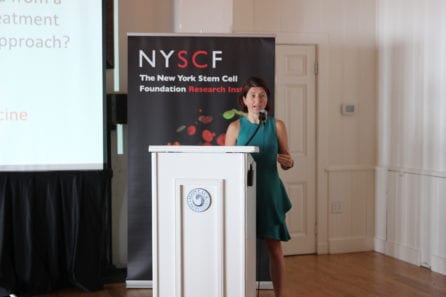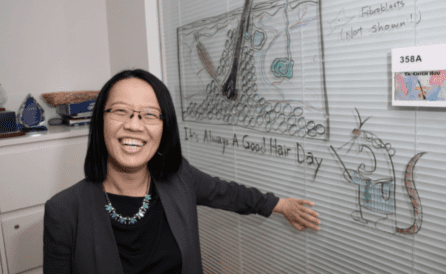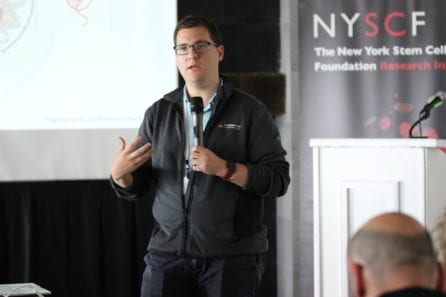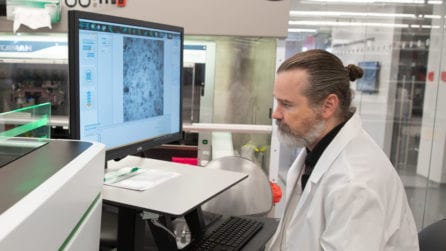Science in the Time of COVID-19: Challenges, Opportunities, And the Path Forward
NewsFeatured image credit: National Institute of Allergy and Infectious Diseases
The COVID-19 pandemic has upended the lives of millions, impacting how people are able (or unable) to perform their work, and scientists are no exception. With many labs shut down and others pivoting towards coronavirus research, there are many challenges facing the STEM community.
At this year’s NYSCF Innovators retreat (held virtually over Zoom last week), our community of leading scientists from institutions around the world discussed how they are managing their labs in this stressful time, how to ensure researchers – especially women and minorities – are supported, and how stem cells can help advance solutions for COVID-19.
Tips for Managing a Lab
With many labs on temporary shutdown and others operating at significantly reduced capacity, adjusting to new circumstances can be difficult — not only logistically, but mentally.
“As managers, we discussed that it’s important to reset people’s expectations and make clear that we understand productivity can’t be the same as it was,” said NYSCF Associate Vice President of Scientific Outreach Raeka Aiyar, PhD. “We aren’t just working from home; we’re working from home during a crisis. Expressing appreciation for people’s efforts in these circumstances is especially important.”
Maintaining a team spirit and informal interactions is also important. NYSCF – Robertson Stem Cell Investigator Kristen Brennand, PhD, of the Icahn School of Medicine at Mount Sinai hosts a weekly, virtual happy hour with her lab where they check in with each other and play games. NYSCF – Robertson Neuroscience Investigator Nicolas Bellono, PhD, of Harvard University now hosts ‘open hours’ online where members of his lab can have more relaxed discussions about their analyses and anything else on their mind.

And as difficult as being separated from the lab bench can be, taking the extra time to strategize, analyze, and reflect on research programs can be a valuable replacement.
“Not everyone has this opportunity depending on their circumstances, but for those who do, it can be helpful to take some time to think,” added Michael Yartsev, PhD, a NYSCF – Robertson Neuroscience Investigator at the University of California, Berkeley. “With everything that goes into typical lab operations, it can be hard to find time to simply come up with new ideas and reassess old ones.”
What’s also key to account for is how the pandemic affects everyone differently, exacerbating unique challenges ranging from childcare to home workspaces to logistics.
“I used to treat everyone in my lab in the same way,” remarked one scientist. “But now I understand that people have individual difficulties in the face of this crisis, and there’s no one-size-fits-all approach. I’m getting better at tailoring my communication.”
Personalized communication ensures that team members are open to sharing concerns and speaking about their experiences, showing where accommodations need to be made.
Supporting Women and Minorities in Science
Women and minorities are impacted by the pandemic to an even greater degree due to family care duties, and it is crucial to implement and advocate for policies to support these groups.
“For example, I have a member of my lab whose family is from a disadvantaged background and has been deeply affected by the pandemic, meaning much of his time and money goes toward helping them,” remarked one scientist. “Allowing for flexibility in schedules and deadlines and ensuring we accommodate his needs has been really critical.”
Many women are now faced with challenge of caring for children while also working full-time from home, and this is impacting the amount of work they are able to get done. A recent study from scientists at the University of Toronto found that across disciplines, women’s publishing rates have fallen relative to men, as evidence suggests that even in dual-career households, women still perform the majority of household duties.

“This is another place where funding can make a difference,” remarked NYSCF – Robertson Stem Cell Investigator Ya-Chieh Hsu, PhD, of Harvard University, emphasizing strategies recommended by NYSCF’s Initiative on Women in Science and Engineering. “Pushing for flexible funding and policies that offer childcare options can hopefully reduce some of the stress put on women.”
Mitigating the Pandemic’s Impact on Scientific Careers
The consequences of work-from-home orders are widespread and will likely last far beyond the end of the pandemic, especially when it comes to career development.
For early-career academic researchers managing their own labs, a major goal is attaining tenure, and doing so requires them to meet demanding milestones on a strict timeline. With laboratory activities on pause, this timeline becomes even less feasible.
“Many institutions have paused their tenure clock for one year, but that might not be enough,” remarked NYSCF Chief Business Officer Elizabeth Schwarzbach, PhD. “Just ramping up lab activities could take six months, and the time lost in the lab could set research back more than a year.”

Lost time also means lost experience for graduate students and postdocs. Extending time for postdocs and graduate students to finish their experiments will require more funding, however.
“It’s important to stress to funding agencies the issues surrounding labs right now and see if there is any way to extend funding or make it more flexible,” said Mitchell Guttman, PhD, a NYSCF – Robertson Stem Cell Investigator at the California Institute of Technology.
“With NYSCF, we are lucky that our awards allow for flexible spending, meaning that even if it is something as simple as purchasing a standing desk for a lab member to make their work-from-home experience easier, we can do so,” added Dr. Hsu.
Redirecting a Lab to Fight COVID-19
Many labs have in the NYSCF community have begun to pivot their focuses – using their unique knowledge and expertise to work toward better understanding of the SARS-CoV-2 virus and new treatments. Stem cells serve as an invaluable tool for modeling exactly how a disease affects human cells and testing potential drugs, and many scientists are taking advantage of these capabilities for COVID-19 research.

“Stem cells capture the genetics of the person from whom they are made, and this is especially helpful for COVID-19 because we are still learning about how individual genetics impact the disease,” remarked NYSCF Senior Vice President of Research Scott Noggle, PhD. “We can look at common and rare genetic differences to see whether certain groups are more susceptible than others and determine which drugs will work for which patients.”
Clusters of human tissue made from stem cells called ‘organoids’ can also illuminate disease processes.
“Organoids give us a glimpse into cell interactions and can effectively model the environment of especially susceptible tissues such as lung tissue,” explained Evangelos Kiskinis, PhD, a NYSCF – Robertson Stem Cell Investigator at Northwestern University.
The special ability of stem cells to infinitely self-renew also make them a possible tool for new therapies.
“Perhaps stem cells could contribute to post-infection lung regeneration in severe cases,” added Dr. Kiskinis. “But that will need further exploration.”
Altogether, our community was inspired by how the pandemic has galvanized scientists worldwide to work together, support each other, and contribute whatever they can to find solutions. While this is a challenging time for all of us, many of the current challenges reflect longstanding issues that have been exacerbated by the pandemic, and it is great to see creative solutions emerging. We look forward to working with everyone to continue to support the research community and advance promising science!
For more information on how the NYSCF community is fueling the fight against COVID-19, see here.

